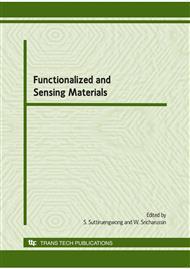p.405
p.409
p.413
p.417
p.421
p.425
p.429
p.433
p.439
Synthesis and Characterization of SnO2 Nanowires Materials Prepared from Tin Powder
Abstract:
Tin dioxide (SnO2) materials are prepared by using vapor transport techniques through a vapor-liquid-solid (VLS) mechanism from Tin (Sn) powder. The SnO2 materials are synthesized onto the silicon substrate at temperatures 850 0C. Crystalline structure of SnO2 nanowires was investigated by X-ray diffraction (XRD) spectroscopy. XRD patterns of SnO2 exhibited tetragonal rutile structure with lattice parameters of a = 4.73 oA and c = 3.18 oA. Surface morphology of SnO2 films was characterized by scanning electron microscope (SEM), that SEM micrographs indicate nanowires-like structure. The Raman spectra of single-crystalline rutile SnO2 nanowires were studied, three vibration modes were observed at 475, 635 and 775 cm-1 corresponded to the typical feature of the SnO2 nanowires. A room temperature photoluminescence (PL) spectrum of SnO2 nanowires were in visible emission range.
Info:
Periodical:
Pages:
421-424
Citation:
Online since:
January 2010
Authors:
Price:
Сopyright:
© 2010 Trans Tech Publications Ltd. All Rights Reserved
Share:
Citation:


